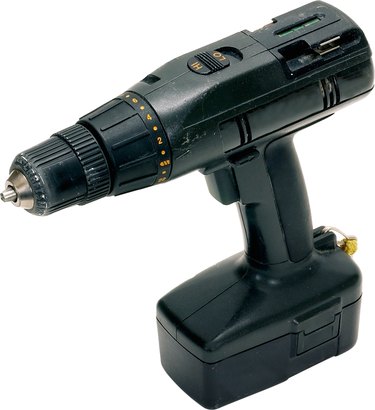Things You'll Need
Drill
1/4-inch wood bit
Countersink bit
Tape measure
Level
3/16-inch mason's bit
Masking tape
2-1/2-inch concrete screws

Builders use ledger boards to attach one structure to another. Typically made of two-by lumber, ledger boards attach horizontally to an existing structure, such as a house or garage, and are used to join a deck, roof or other add-on to the original structure. Successfully attaching a ledger to a cinder block can be accomplished by using the right hardware.
Step 1
Drill pilot holes in your ledger board. For this example, assume a 2-inch by 6-inch ledger board. Use a 1/4-inch wood bit to drill pilot holes every 8 to 10 inches along the length of your board. Use a countersink bit to countersink each hole to allow the screw heads to run flush with the face of the ledger board.
Video of the Day
Step 2
Determine what height on the cinder block you need to attach your ledger and use a tape measure to mark the placement for all four corners of the ledger board on the cinder block.
Step 3
Hold the ledger board in place and use a level to double-check the pitch. Attaching a deck or roof ledger board at less than perfect level can cause deck or roof supports to fail later. Line up the level's bubble perfectly in the center of the indicator marks.
Step 4
Use a 3/16-inch mason's bit to drill through each pilot hole in the ledger board into the cinder block to a depth of 1/8 inches. This will mark the locations for the pilot holes in the cinder block.
Step 5
Use a piece of masking tape to wrap around the 3/16-inch mason's bit at a point 1-1/4 inches from the tip of the bit. This will serve to indicate the depth of the pilot holes in the cinder block.
Step 6
Set aside the ledger board and drill each marked pilot hole to a depth of 1-1/4 inches. Use steady pressure and avoid tipping the drill side to side to ensure a perpendicular pilot hole. Blow the dust from the holes to allow the screw to function properly.
Step 7
Hold the ledger board in place on the cinder block. Line up the pilot holes in the board with those on the block. Beginning from one end drive one 2-1/2-inch Tapcon-style concrete screw through each pilot hole in the board and into the cinder block. Repeat for each hole, making sure that each screw is run all the way in until the head is flush with the face of the ledger board.
Tip
If you are using a rotary drill, then use a rotary mason's bit and not one designed for a hammer drill. Check the packaging for details.
Warning
Always use eye protection when using power tools.
Video of the Day